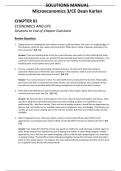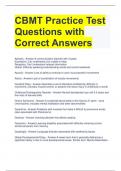SOLUTIONS MANUAL
Microeconomics 3/CE Dean Karlan
CHAPTER 01
ECONOMICS AND LIFE
Solutions to End-of-Chapter Questions
Review Questions
1. Suppose you are shopping for new clothes to wear to job interviews, but you’re on a tight budget. In
this situation, what are your wants and constraints? What does it mean to behave rationally in the
face of scarcity? [LO 1.1]
Answer: If you are deciding what to buy for a job interview, your want is to buy clothing that looks
clean and professional, so you can present the best possible impression to potential employers. Your
constraint is the amount of money you can spend on this clothing. A person behaving rationally
would buy the nicest clothes they could afford.
2. You are a student with a demanding schedule of classes. You also work part-time and your
supervisor allows you to determine your schedule. In this situation, what is your scarce resource?
How do you decide how many hours to work? [LO 1.1]
Answer: Your scarce resource is time. You need both time to study and time to work. Presumably,
you want to do well in school and also make money. You will try to balance your schedule so that
you work as much as possible while still having enough time to study and do well in school.
3. Think about the definition of scarcity that you learned in this chapter. Name three ways that you
confront scarcity in your own life. [LO 1.1]
Answer: We face scarcity in many aspects of our lives. I love to travel and explore new places. I face
scarcity in both time and money that keeps me from traveling as often as I would like. In my
professional life, I also face scarcity. There are lots of worthy projects I would like my department to
take on, but I am limited in my available resources of employees, time, and budget. Collectively, as a
society, we want more camping sites in the summer months. But there are limited number of sites
available.
4. When shopping for your interview clothes, what are some trade-offs you face? What is the
opportunity cost of buying new clothes? What are the benefits? How do you balance the two? [LO
1.2]
Answer: One trade-off is that the money you spend on clothes for a job interview could be spent on
other things instead. One opportunity cost of buying new clothes is other things forgone. Another
opportunity cost is the time you spend shopping, which could be spent preparing for your interview
or playing Frisbee. The benefits include looking put-together during the interview, which provides a
boost to your job prospects. You balance the costs and benefits by accepting costs that are less than
(or no greater than) the benefits they provide.
,5. You have an 8:00 class this morning but you are feeling extremely tired. How do you decide whether
to get some extra sleep or go to class? [LO 1.2]
Answer: If you are behaving rationally, you decide by comparing the trade-offs. The opportunity
cost of going to class is missing out on some extra sleep. Depending on what else is on your schedule
that day (perhaps an important job interview), it may make sense to choose extra sleep over class.
The opportunity cost of extra sleep is that you will miss the lecture. If your grade will suffer
significantly by your absence, you may want to grab some coffee and go to class!
6. It’s Friday night. You already have a ticket to a concert, which cost you $30. A friend invites you to
go out for a game of paintball instead. Admission would cost you $25, and you think you’d get $25
worth of enjoyment out of it. Your concert ticket is nonrefundable. What is your opportunity cost (in
dollars) of playing paintball? [LO 1.2]
Answer: The opportunity cost of going to play paintball is whatever amount of enjoyment (in
dollars) you would get out of going to the concert. The thirty dollars you paid for the concert ticket is
not relevant to the decision, as it is a sunk cost and is nonrefundable regardless of what you do.
7. Suppose you have two job offers and are considering the trade-offs between them. Job A pays
$45,000 per year and includes health insurance and two weeks of paid vacation. Job B pays $30,000
per year and includes four weeks of paid vacation but no health insurance. [LO 1.2]
a. List the benefits of Job A and the benefits of Job B.
b. List the opportunity cost of Job A and the opportunity cost of Job B.
Answer:
a. The benefits of Job A are the extra pay and health insurance. For Job B, the benefit is two extra
weeks of vacation.
b. The opportunity cost of Job A is losing out on the extra two weeks of vacation that comes with
Job B. For Job B, the opportunity costs are the extra $15,000 in salary along with the health
insurance.
8. Your former neighbor gave you his lawnmower when he moved. You are thinking of using this gift to
mow lawns in your neighborhood this summer for extra cash. As you think about what to charge
your neighbors and whether this idea is worth your effort, what opportunity costs do you need to
consider? [LO 1.2]
Answer: You need to consider the opportunity cost of mowing lawns. Your lawn mowing business
would need to cover the opportunity cost of what you could earn in another summer job. You also
need to consider the cost lawn mowing (e.g. of gasoline for the mower) and the value of the lawn
mower itself. Just because it was a gift does not mean that it has no opportunity cost. The
opportunity cost of using the lawnmower for your business is its sale value, if you decide to sell the
gift rather than use it yourself. Your lawn mowing business needs to cover all of these costs (the
value of your time in another job, gasoline, and the sale value of the lawnmower) in order for it to
be a worthwhile endeavor.
,9. Think of a few examples of incentives in your daily life. How do you respond to those incentives?
[LO 1.2]
Answer: Throughout the day, I am reminded to not park in the wrong spot (lest I get a ticket), get
five cents for every glass I recycle, and set aside five percent of my income to a RRSP. For the most
part, I respond rather favorably to these incentives.
10. You supervise a team of salespeople. Your employees already receive a company discount. Suggest a
positive incentive and a negative incentive you could use to improve their productivity. [LO 1.3]
Answer: For a positive incentive, you could offer a reward such as a bonus, a gift certificate, or an
extra discount on company merchandise to the most productive employee of the month. For a
negative incentive, you could announce that employees who fail to meet targets will lose their
company discount.
11. Your boss decides to pair workers in teams and offer bonuses to the most productive team. Why
might your boss offer team bonuses instead of individual bonuses? [LO 1.3]
Answer: Your boss is creating a reward system for a project that requires group effort. Even if you
are not motivated to compete for an individual bonus, you are likely to feel responsibility to your
teammate and make a greater effort to be productive. Your teammate can encourage, pressure,
and/or help you to achieve greater productivity.
12. Think of a public policy—a local or national law, tax, or public service—that offers an incentive for a
particular behavior. Explain what the incentive is, who is offering it, and what they are trying encourage
or discourage. Does the incentive work? [LO 1.3]
Answer: Provincial and federal governments provide subsidy on green energy projects. This provides
an incentive for electricity producers to switch their production to renewable sources. They are
trying to encourage the production of green energy to reduce the carbon emission in Canada. This
incentive will help reduce greenhouse gas emission by changing the composition of electricity
production in the long run.
13. Why do individuals or firms usually provide the goods and services people want? [LO 1.4]
Answer: It is for their own private interests that Individuals or firms provide goods and services
people want. By fulfilling what people (buyers) want, individuals and firms also receive what they
themselves want. If firms didn’t produce goods that people want, no one would buy their goods.
These firms would lose money and go out of business, and would be replaced by firms that did
produce goods that customers want.
14. You may have seen TV advertisements for products or programs that claim to teach a surefire way
to make millions on the stock market. Apply the Why isn’t everyone already doing it? test to this
situation. Do you believe the ads? Why or why not? [LO 1.4]
, Answer: Guessing which stocks are going to perform well and which are going to tank is a hard if not
impossible task, which makes it very hard to make millions in the stock market. You should not
believe the ads for that reason. (If there really was a surefire way to make millions, you can bet
everyone would already be doing it!)
15. Describe an innovation in technology, business, or culture that had a major economic impact in your
lifetime. [LO 1.4]
Answer: The Internet has completely changed the way people do business. While writing this
textbook, we have collaborated with people all over the country, sharing documents online that we
once would have had to send through the mail.
16. Why do people confuse correlation with causation? [LO 1.5]
Answer: Correlation means that two events occur together. Since the two often occur together,
people often believe that one causes the other, but this is not always true. People once thought that
ice cream caused polio, for example. The real relationship was that people ate more ice cream in the
summer, and this also happened to be the time of year that the polio virus spread more rapidly. It is
sometimes the case whether a relationship is correlative and causal is hard to detect, due to for
example the lack of sufficient data or knowledge.
17. Name two things that are positively correlated and two things that are negatively correlated. [LO
1.5]
Answer: Things that are positively correlated tend to occur together. In my household, candy and
children are positively correlated. I don’t have much of a sweet tooth, but I always stock up on
candy when the nieces and nephews visit. Things that are negatively correlated tend not to occur
together. According to auto insurers, good grades and the risk of getting in a car accident are
negatively correlated. (People with higher grades tend to be safer drivers.)
18. Why is it important for a good economic model to predict cause and effect? [LO 1.6]
Answer: A good model must predict cause and effect so that it can explain something about what
we have observed and can help us anticipate what will happen in future observations.
19. Why is it important for a good economic model to make clear assumptions? [LO 1.6]
Answer: A good model must make clear assumptions so we know when the model will do a good job
at explaining or predicting our observations and when it will not.
20. What is the difference between disagreeing about a positive statement and disagreeing about a
normative statement? [LO 1.7]
Answer: A positive statement is something that is supposed by fact, whereas a normative statement
is a value judgment. So disagreeing with a normative statement means you disagree with someone’s
opinion. Disagreeing with a positive statement means disputing the truth of fact.





